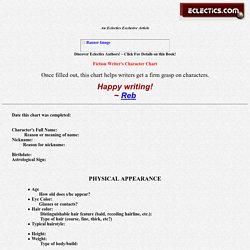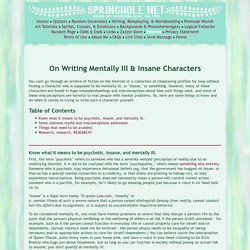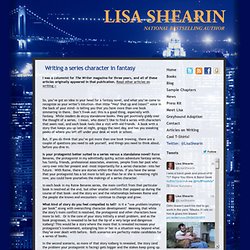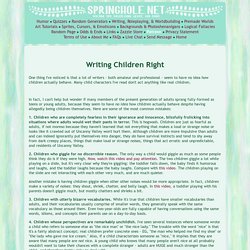

Characters For an Epic Tale ☑ Common, Yet Terrible Character Descriptors - And How To Fix Them. When asked to describe their characters, many people tend to use the same over-generalized descriptors over and over.

The result tends to be what I call a "Forer profile" - it's so vague that it can fit any number of characters - all of whom are wildly different - equally well. And when the same character description could fit a sneaky trickster as it could a determined soldier as it could a grad student opening a florist's shop, that's a problem. The Female Character Flowchart.
Character Profile. Character Chart. FAVORITES Color: Music: Food: Literature: Expressions: Book: Quote: Expletive(s) (swears): Mode of transportation: HABITS Smokes: What?

How often? Drinks: What? How often? Worst bad habit? Character. Writing Mentally Ill and Insane Characters. You can't go through an archive of fiction on the Internet or a collection of roleplaying profiles for long without finding a character who is supposed to be mentally ill, or "insane," or something.

Writing a Novel with Unforgettable Characters. Character development is one of the first essential steps of writing a novel and it involves creating the people who will carry out your story.

Writing a Series Character. I was a columnist for The Writer magazine for three years, and all of these articles originally appeared in that publication.

Read other articles on writing » So, you’ve got an idea in your head for a fantasy novel, and what you’ve come to recognize as your writer’s intuition—that little “Hey! Shut up and listen!” Voice in the back of your mind—is telling you that you have more than one book simmering in there. Don’t freak out; this is a good thing, especially with fantasy.
But, if you do think that you’ve got more than one book brewing, there are a couple of questions you need to ask yourself, and things you need to think about, before you dive in. Creating the Hero. Where would the Harry Potter series be without Harry Potter, or the Lord of the Rings series without Frodo?

What would the Barbarians be without Conan? The hero of a fantasy novel will have a great deal to do with whether the novel succeeds or fails, so it's important to create a good one. Here are some guidelines to help you get started. 1. The hero must be isolated. Character Development. Writing Sympathetic Morally-Ambiguous Characters. Let’s face it: real life doesn’t neatly sort itself into tidy little good and bad/right and wrong piles for our convenience and ease of mind.

Very often we have to face situations that force us to consider our values and what we really believe and why we believe them, or force us to pick what we can only hope is the lesser of two evils. If what we write is to accurately reflect reality, then this this fact cannot be ignored. Morally-ambiguous characters can offer a chance to explore situations and issues that don’t have clear-cut answers… and sometimes, they’re just a refreshing change from straight-and-narrow characters.
On the downside, morally ambiguous characters who aren’t handed well can quickly become obnoxious and even repugnant. So, here are some things to keep in mind to help keep them relatively sympathetic and believable to audiences. However, the character should have to grapple over major decisions where the implications of each choice are understood by the character. Writing Children. One thing I've noticed is that a lot of writers - both amateur and professional - seem to have no idea how children actually behave.

Many child characters I've read don't act anything like real children. In fact, I can't help but wonder if many members of the present generation of adults sprang fully-formed as teens or young adults, because they seem to have no idea how children actually behave despite having allegedly being children themselves. Here are some of the most common mistakes: 1. Children who are completely fearless in their ignorance and innocence, blissfully frolicking into situations where adults would wet their pants in terror. 2. Guide for Writers: Characters. Most stories are remembered for their characters, not specific plot points.

If you want to write a memorable story, create memorable characters. They do not need to be believable — they need to be dramatic. It Takes Two Often, the best stories are deceptively simple: there are two main characters for the reader to follow. There is a central character and an opposition character. The central character is the character a reader or viewer “follows” through the story. The opposition character can be “good” or “evil” depending on the role of the central character.
Other - How to Create Realistic and Believable Characters. How to Write a Character From Start to Finish. The best fiction is about a character who changes in some significant way.

The selfish brute learns to put others first. The woman marrying for money decides to marry for love. The career ladder climber learns to cut back on his hours to enjoy his family. Things To Know If Your Character Will Be Augmented Or Experimented Upon. Far, far too many stories and backstories where characters are experimented upon or augmented rely on characters doing things that almost no real person with any sort of sense would do in their positions. So here are some things to know and keep in mind about scientists, the scientific process, and a few other things so you can make your own stories more plausible. There is a big difference between an experiment and a project.
To put it simply, an experiment is a test intended to result in new or expanded knowledge about something or to verify a claim or suspicion about the way something works or behaves. It isn't about simply doing something you're not sure about and hoping to get a result you like, but is about trying or testing something and learning from whatever results you get, whether they're the ones you hoped for or not. In fact, learning and progressing from one's failures and mistakes is a huge part of the scientific process. So, in summary... Connect Your Characters to Settings in Your Novel.
We’ve been looking at settings in your novel: the overall milieu or locale that your story takes place in, as well and the various locations your scenes are set in. I’ve encouraged you to take the time to come up with fresh, significant settings instead of defaulting to the easiest and first location types that come to mind, such as restaurants and coffee shops. We spend a lot of our time at work and home, and occasionally at those restaurants and coffee shops, but that is ordinary life. And while we want to show our characters in their ordinary lives (at least sometimes), readers don’t want “boring.” Describing Your Character: Tips & Advice. They say first impressions are the most important, and with characters that is definitely true.
The way you describe your characters for the first time can make or break peoples' impressions of your characters and your story. So, here are some tips and advice on describing your characters in-story. Give out appropriate amounts of detail. Wonder Baby Syndrome. I took stock of commonly-disliked canon progeny and tried to work out what they had in common. After reviewing various disliked offspring, I've noticed that they tend to exhibit the following three traits: The offspring has powers or abilities rivalling or exceeding those of one or both parents.The offspring uses those powers or abilities to advance the plot without the parents having to raise their offspring through a normal childhood first.
(Rapid growth, time-travel shenanigans, or being a super-powered baby are examples of how this can work.)The offspring becomes the main source of conflict and/or plays a crucial role in solving the conflict in the plot or plot arc. A few examples: In Breaking Dawn, Renesmee has amazing vampire powers, she's uncannily smart (adult-level awareness from the moment of birth, in fact), she grows rapidly so she can become an active player in the drama, and the entire conflict of Breaking Dawn is centered on her. Then there's River Song from Doctor Who. How to Make Characters Vulnerable.
Most tips for creating sympathetic characters point out that our characters need flaws. And that’s very true. Creating Convincing Characters. As I launch the new Writing Coach website, I thought it would be a good idea to also celebrate the history of The Writing Coach by beginning this series of blog posts and articles from my own archive. In coming weeks I’ll be sharing some of my favourite archive articles. This image of the author John Fowles inspired the character Harold Bliss in my novel Bluethroat Morning This one “Creating Convincing Characters” is more a series of notes than an article. I prepared the notes for a talk I gave at the Cheltenham Literary Festival in 2005.
I hope you find them useful. Write Better Characters. The very first novel I, aged 20-something, wrote, is unpublished and will stay that way. An ensemble coming-of-age story of four teenagers, its weaknesses are legion: tame story line, thin action, unimaginatively rendered settings, hackneyed themes (though I will say the dialogue wasn’t bad). Having now published seven novels, I look back on that manuscript and realize that underlying the shortcomings I just mentioned lies its principal flaw: poor character development. The kids just don’t pop. Things You Should Know About Your Character.
Previous iterations of the “25 Things” series: 25 Things Every Writer Should Know 25 Things You Should Know About Storytelling And now… Here you’ll find the many things I believe — at this moment! Characterisation. Avoiding Unlikeable Characters. Essential Elements of Character Creation. Creating Compelling Characters.
1. Make the character exceptional at something. Developing Characters. By Jody Hedlund, @JodyHedlund. Effective Character Descriptions. The following is an excerpt from Word Painting Revised Edition by Rebecca McClanahan, available now! The characters in our stories, songs, poems, and essays embody our writing. Introducing Characters - First Impressions. Creating Great Heroes and Heroines. Write Better Chosen Ones. Writing Cute Characters. Improve Your Character Writing. The Most Important Things To Know About Your Character. Craft Compelling Characters.